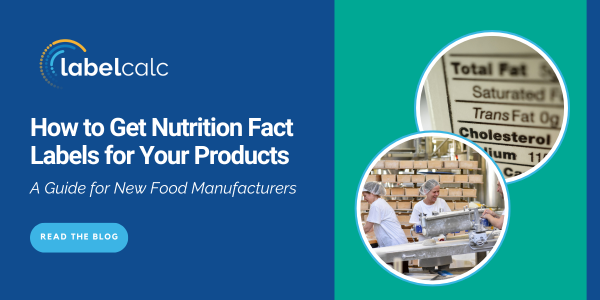Jack was perplexed. “How the heck do I get nutrition facts for my product?”, he asked. I could hear the slight panic in his voice over the phone.
He’d already perfected each of his recipes in his line of gourmet hummus, he’d chosen and ordered his packaging, and he’d designed his package label. Just when he thought he was ready to pitch his product to a local grocery store chain, a colleague kindly pointed out that he’d forgotten an incredibly important part of his product—the nutrition facts label.
Having worked in the food labeling industry for over a decade, I know Jack’s mistake is quite common. But because having a FDA-compliant nutrition facts panel is such a critical part of any product pitch, it’s good to be well-informed of your options for making a nutrition facts panel so you can choose the best method for you.
In order to answer Jack’s question—one I get asked by new food manufacturers on a daily basis—I am going to walk you through all the ways you can obtain a nutrition facts label for your product, explain the pros and cons of each, and then discuss the simplest and most affordable way to create a nutrition facts label yourself.
Ways To Obtain A Nutrition Facts Label: Weighing The Options
Before he called me, Jack was scrambling to find a quick and affordable solution to his problem, so he went online and began researching how he could get a nutrition facts panel. By the time we chatted, he had a pretty good idea of his options, but he couldn’t find much info on how each method worked or what the benefits and drawbacks were.
So, I broke the three main options down for him like this:
Food Lab
While food labs can provide accurate nutrition results, the cost, the hassle and the wait time are often not worth it. Analysis of a single food product can cost $800 dollars or more—so this wouldn’t be a good choice for someone like Jack who has multiple products. Food labs recommend sending composite samples of several different preparation batches or lots to increase the odds of getting the right result. It can take a lot of time to gather and prepare and ship representative samples. It can also take a long time to get results – usually about 2 -4 weeks from the time the lab receives your product.
Also, keep in mind that each time you tweak your product—something food manufacturers do frequently—you will have to send another sample for analysis.
As a rule, you only need to use a food lab if your product is deep fried, fermented or heavily processed.
Independent Company/Consultant
Having an independent company or consultant create your nutrition facts panel is a fairly common choice for those who do not want to conduct the nutrition analysis themselves. While it can be nice having someone else take care of the task for you, you will need to provide detailed information about your recipe, ingredients, process and packaging. This is often less expensive than laboratory testing, but still comes at a steep price, and if you want to alter your recipe in any way, you will have to pay additional fees. Additional charges also usually apply for more specific information about your product, like what nutrient content claims it qualifies for (i.e. low-fat).
Web-based Nutrition Analysis Software
Of all the options, this is the quickest and most efficient way to get your nutrition facts panel. FDA-compliant online software is not only user-friendly, but cost effective as well.
We link to the USDA’s database which contains hundreds of thousands of pre-analyzed ingredients. If an ingredient isn’t in the database, you can easily add it.
How to Get Nutrition Facts for Your Product Simply and Affordably
Given a limited budget, potential time constraints, and the need to constantly improve and adjust your product, a web-based nutrition analysis software is the best way to attain your nutrition facts panel.
To give you an idea of how simple the process can be, I’ll outline the steps involved from start to finish:
- Create an account with a username and secure password.
- Sign in to your account and enter your product recipe and serving size.
- The software will immediately generate your FDA-compliant nutrition facts label, ingredient and allergen statements.
- Modify your ingredients, amounts, serving size, and label layout, if desired. If you have multiple variations of the same product, use the duplicate function to quickly create a new recipe to alter.
- Download the completed label and print.
Depending on the complexity of your particular product, this process should only take an hour or two at most the first time you do it. Every time thereafter, it can take as little as a few minutes.
In the end, Jack ended up using a web-based software to make his nutrition facts labels for his hummus line, which saved him a lot of time, money, and stress. While nutrition facts may seem complicated to create yourself, especially if you’ve never done it before, the right web-based nutritional analysis and label generator makes the label generation process quite simple.
About LabelCalc
LabelCalc, a Datacor company, is used by food manufacturers worldwide to generate accurate nutrition facts labels quickly and easily. Within just a few mouse clicks, the intuitive and user-friendly software compiles relevant information about ingredients, nutrition information, serving sizes, and allergens – all correctly formatted and compliant with the latest FDA rules. Not only is it proven to save a lot of time, but there’s also no need to worry about any calculations or math behind the scenes – LabelCalc does all the hard work for you!
If you have any questions about our trusted software solution, email Tracy Herb, Product Owner – LabelCalc, at tlherb@datacor.com. To get a quote or request a demo, visit https://labelcalc.com/contact-us/.

